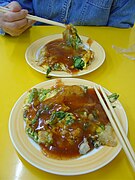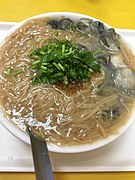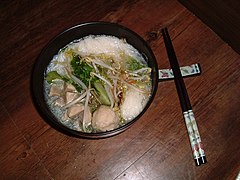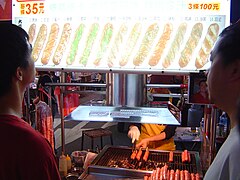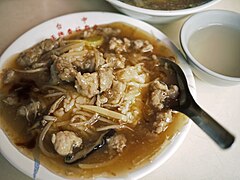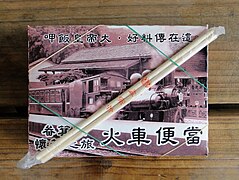
Taiwanese cuisine (臺灣料理; Táiwān liàolǐ; Tâi-oân liāu-lí, Bopomofo: ㄊㄞˊㄨㄢˉㄌㄧㄠˋㄌㄧˇ, or Chinese: 臺灣菜; pinyin: Táiwāncài; Pe̍h-ōe-jī: Tâi-oân-chhài, Bopomofo: ㄊㄞˊㄨㄢˉㄘㄞˋ) is a popular style of food with several variations, including Chinese and that of Taiwanese indigenous peoples, with the earliest cuisines known of being the indigenous ones. With over a hundred years of historical development, mainstream Taiwanese cuisine has been influenced by Hakka cuisine, the cuisines of the waishengren (people of other provinces), Japanese cuisine, and American cuisine, with southern Fujian cuisine having had the most profound impact.[1]
Taiwan's cuisine is tied to its history of colonization and modern politics makes the description of Taiwanese cuisine difficult. As Taiwan developed economically fine dining became increasingly popular. Taiwanese cuisine has significant regional variations.
Night markets in Taiwan form a significant part of the food culture. Vegetarian and vegan food are very common. Taiwanese cuisine is popular around the world with some items like bubble tea and Taiwanese fried chicken becoming global phenomena.
History
[edit]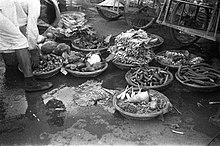
According to Katy Hui-wen Hung, "Taiwanese food history is as murky as Taiwanese politics". This is because Taiwanese cuisine is intricately tied to patterns of migration and colonization. Local and international Taiwanese cuisine, including its history, is a politically contentious topic.[2][3] Taiwan's complex and diverse identity makes Taiwanese cuisine difficult to define.[4][5] Tense political relations between Taiwan and China also complicate the history.[6]
The history of Taiwanese cuisine began with the cuisine of the aboriginal peoples of the islands of Taiwan. In the 16th century Fujianese and Hakka communities immigrated to Taiwan and brought their cuisines with them. Due to this part of its heritage Taiwanese cuisine is often misrepresented as part of regional Chinese cuisine. Early European influences came from the Dutch, Spanish, and Portuguese.[7]
Due to the period of Japanese rule, Taiwanese cuisine was also strongly influenced by Japanese washoku and yōshoku.[citation needed] During Japanese rule Japanese dishes and foodways such as bento,[8] sashimi, rice balls, and miso soup were introduced to Taiwanese cuisine.[7]
After WWII, the Kuomintang retreat to Taiwan brought along many Chinese cuisines outside the province of Fujian or Southeast China. After that, the dishes from whole mainland China especially Guangdong, Chaoshan, Shanghai, Sichuan and Beijing could be easily found in Taiwan.[citation needed]
According to Taiwanese chef Fu Pei-mei, authentic Chinese culinary traditions were properly preserved in Taiwan. This claim to authenticity, common among Fu's generation, was in part due to the Kuomintang's Chinese nationalist political messaging which extended well beyond cuisine.[9] The authenticity of regional Chinese cuisine in Taiwan has been challenged.[6] Some sources trace the origin of instant noodles to Taiwan's jisi noodles, in particular a variation deep-fried in pork fat to be later boiled in water before serving introduced by the Qingji Ice Dessert Parlor in 1951. Following the commercialization of instant noodles Taiwanese companies including Uni-President. In 1973 Wei Lih Food Industrial introduced the first packaged instant noodle meant to be consumed "dry" (without soup or with soup on the side).[10]
The Tatung electric steamer was introduced in the 1960s and became a staple of Taiwanese home and restaurant kitchens.[11] The widespread adoption of the food court during the 20th century formalized more traditional hawkers and vendors. Food courts also became an important part of the malls and shopping centers which proliferated across Taiwan.[8]
In 2002, the ascension of Taiwan to the World Trade Organization forced Taiwanese farmers to compete with global markets. Many responded by shifting from staple crops to high end and niche produce primarily for local consumption. Agrotourism was also more widely adopted, with visitors to farms often being served and/or taught how to prepare dishes with the products from the farms.[12]
In the early 21st century, ideas about sustainability and local food became more prominent in Taiwanese culinary and agricultural circles.[13] An increased emphasis has been placed on understanding the history of food as well as incorporating indigenous foodways into mainstream Taiwanese cuisine.[6]
Ingredients and culture
[edit]


Common ingredients of Taiwanese cuisine are pork, seafood, chicken, rice, and soy.[14] Traditionally, rice formed the basis of most Taiwanese diets. Before the Japanese colonial period, most rice grown in Taiwan was long-grained indica rice. The Japanese introduced short-grained japonica rice which quickly changed both the farming and eating patterns of the Taiwanese. Due to Japanese influence, the Taiwanese generally prefer rice that is plump, aromatic, slightly firm, and sweet. Differences between the Taiwanese and Japanese rice preferences are demonstrated by differences in their cuisine with Taiwan's more flavorful and aggressive cooking methods calling for highly aromatic rice while the Japanese prefer a more subtle and pure taste and smell.[15] During the Japanese Colonial period, Taiwanese cuisine was divided. High-end restaurants, or wine houses, served Chinese cuisine such as Peking duck, shark fin with bird's nest soup, and braised turtle to the colonial elite. In the meantime, those without wealth or connections primarily ate rice, porridge, pickled vegetables, and sweet potato leaves. Cooking oil was considered a luxury and was only used for special occasions.[16]
Taiwan's cuisine has also been influenced by its geographic location. Living on a crowded island, the Taiwanese had to look aside from the farmlands for sources of protein. As a result, seafood figures prominently in their cuisine. This seafood encompasses many different things, from large fish such as tuna and grouper,[17] to sardines and even smaller fish such as anchovies. Crustaceans, squid, and cuttlefish are also eaten.[citation needed] Milkfish is the most popular fish in Taiwanese cuisine; it is valued for its versatility as well as its tender meat and economical price.[18]
Beef is less common than other proteins, and some Taiwanese (particularly the elderly generation) still refrain from eating it.[14] This stems from traditional reluctance toward slaughtering precious cattle needed for agriculture, and an emotional attachment and feeling of gratitude and thanks to the animals traditionally used for very hard labor.[14] However, due to influences from the influx of mainland Chinese in the 1900s, the Taiwanese version of beef noodle soup is now one of the most popular dishes in Taiwan. American food aid in the decades following WWII which primarily consisted of wheat, beef, and processed meats like Spam permanently changed the Taiwanese diet with wheat-based noodles, breads, and dumplings taking a more central role in the cuisine.[3] Rice consumption in Taiwan reached a height of 80-90 kilograms per person per year in the 1960s and 1970s before falling as consumers shifted consumption to wheat-based foods. However, the Taiwanese still consume a large quantity of rice, particularly brown rice and exotic varieties like black, purple, and red rice. Recently rice consumption in Taiwan has enjoyed a renaissance with both growers and consumers devoting the level of care and attention to the rice that is given to high-value crops like tea.[15]
Dumplings were a minor part of Taiwanese cuisine until the expansion in wheat consumption following WWII. Dumplings and dumpling like foods (such as xiaolongbao which is actually a small steamed bun because its wrapper contains yeast) are very popular in modern Taiwanese cuisine with most combining Chinese and Taiwanese influences. In Taiwan dumplings are often paired with hot and sour soup.[19]
Because of the island's sub-tropical location, Taiwan has an abundant supply of various fruit, such as papayas, starfruit, melons, and citrus fruit. A wide variety of tropical fruits, imported and native, are also enjoyed in Taiwan. Other agricultural products in general are rice, corn, tea, pork, poultry, beef, fish and other fruits and vegetables. Fresh ingredients in Taiwan are readily available from markets.[20]
In many of their dishes, the Taiwanese have shown their creativity in their selection of spices. Typical spice mixes in Taiwanese cuisine are five spice powder and hujiaoyan (a mixture of white pepper, salt, MSG, and sugar).[21] Taiwanese cuisine relies on an abundant array of seasonings for flavor: soy sauce, rice wine, sesame oil, fermented black beans, pickled radish, pickled mustard greens, peanuts, chili peppers, cilantro (sometimes called Chinese parsley)[22] and a local variety of basil (九層塔; káu-chàn-tha̍h; 'nine-story pagoda').[23] Widespread use of sugar is part of the legacy of Taiwan's commercial sugar industry.[24][25]
Taiwanese black vinegar has more in common with Worcestershire sauce than other black vinegars and is considered an outlier among black vinegars. Its base is sticky rice which is then aged with other ingredients in clay pots. It is used as a condiment and seasoning. Kong Yen is the largest producer of Taiwanese black vinegar. According to Bon Appetit, compared to Chinese black vinegars it is "simpler, fruitier, and cleaner."[26] Taiwanese soy paste is a soy sauce based paste thickened with rice flour and sugar.[27] Taiwanese mayonnaise is made with both egg whites and egg yolks and is sweetened.[28]
An important part of Taiwanese cuisine is xiaochi (小吃),[29] substantial snacks along the lines of Spanish tapas or Levantine meze. The Taiwanese xiaochi has gained much reputation internationally. Many travelers go to Taiwan just for xiǎochī. The most common place to enjoy xiǎochī in Taiwan is in a night market. Each night market also has its famous xiǎochī.[3] Moreover, the Taiwanese xiǎochī has entered more "refined" eating environments. Nowadays, Taiwanese xiǎochī can be found in luxury and high-end restaurants. These restaurants use higher quality ingredients and creative presentations, reinventing dishes whilst keeping the robust flavors. The prices usually jump by twice the price or even higher in the restaurants. The Taiwanese government supports the Taiwanese xiǎochī and has held national xiǎochī events in Taiwan regularly.[citation needed]
Grilling is an important part of Taiwanese cuisine with many Taiwanese grilling at home and street side grills being a ubiquitous feature of night markets.[30]
Modern Taiwanese cuisine is influenced by Taiwan's freedom and openness which enables chefs to innovate and experiment.[31]
Roadside banquet chefs are ubiquitous in Taiwan; these small (often single-person) catering firms provide on-location cooking for wedding banquets and other celebrations often held on the roadside. During the COVID-19 pandemic these chefs saw a significant downturn in business due to the lack of people hosting large traditional functions, especially those around the Lunar New Year.[32] The banquet industry returned after the pandemic but have faced criticism for a lack of innovation and the repetition of traditional dishes.[33]
Vegetarianism and veganism
[edit]Vegetarian restaurants are commonplace in Taiwan with a wide variety of dishes, mainly due to the influence of Buddhism and other syncretistic religions like I-Kuan Tao.[14] These vegetarian restaurants vary in style from all-you-can-eat to pay-by-the-weight and the regular order-from-a-menu. Vegetarian restaurants and foods are often marked with a left-facing swastika.[34]
In the 21st century, Taiwan has seen a rise in non-religious vegetarians, especially among the young. There has also been a rise in veganism with concerns about animal welfare, personal health, environmental sustainability, and climate change driving both trends.[35] Taiwan's traditional vegetarian products companies have also expanded into the booming fake meat market. The traditional culinary use of fake meat in Taiwan has given Taiwanese companies an edge and Taiwan is now a market leader in the fake meat sector. Taiwanese companies do a significant amount of export business, particularly in the European, North American, and Southeast Asian markets. Hung Yang Foods, one of the largest producers of fake meat products, does 80% of their business overseas with their products being stocked in 90% of Australian supermarkets.[36]
In 2023, there were approximately 6,000 vegetarian restaurants in Taiwan.[37]
Regional specialties
[edit]| Region | Dish | Han Characters | Taiwanese Hokkien (Tâi-lô) | Description | Photo |
|---|---|---|---|---|---|
| Changhua | ba-wan | 肉圓 | bah-ôan | Literally meaning 'meat sphere'. They are a kind of large dumpling made from a gelatinous tapioca starch dough and stuffed with pork and vegetables, most commonly mushrooms and bamboo shoots.[18] | 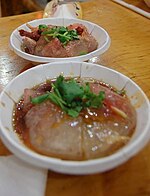
|
| Chiayi | turkey rice | 火雞肉飯 | hoe-koe bah-pn̄g | Bowls of rice with shredded turkey layered on top, often accompanied by pickled radish. The rice is drizzled with a kind of gravy made from the turkey drippings and soy sauce.[38] | 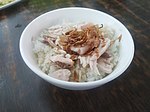
|
| Chiayi/Tainan | Coffin bread | 棺材板 | koann-chhâ-páng | Similar to French toast or bread bowl soups, but filled with savory fillings, such as black pepper beef or curried chicken. Thick-cut bread is dipped in egg, deep fried, cut along three sides, opened and filled, and eaten.[39] | 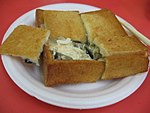
|
| Daxi | Daxi dried tofu | 大溪豆乾 | Tāi-khe tāu-koaⁿ | Firm tofu fried and braised in a sweet soy-based sauce and then dried.[40] | |
| Hsinchu | pork balls | 貢丸 | kòng-ôan | Often eaten in soup (湯; thng).[41] | 
|
| Hsinchu | rice vermicelli | 米粉 | bí-hún | Thin al-dente rice noodles. Often eaten 'dry' (乾; ta/kan, without soup) with mushroom and ground pork.[42] | |
| Nantou | yi mein | 意麵 | ì-mī | Soft tender noodles in soup.[citation needed] |  |
| Taichung | suncake | 太陽餅 | One of the most noted pastries of Taichung, suncake is a baked layered puff pastry with a sweet center often made with honey or molasses.[43][44] | 
| |
| Tainan | milkfish congee | 虱目魚肚粥 | Breakfast dish consisting of a congee with milkfish belly. | 
| |
| Tainan | ta-a mi | 擔仔麵 | tàⁿ-á-mī | Also known as slack season noodles. Yellow "oily noodles" shown served with minced pork, shrimp, bean sprouts, cilantro, black vinegar, garlic, soy sauce and egg.[18] | 
|
| Tainan | shrimp and pork meatballs | 蝦仁肉丸 | hê-jîn bah-ôan | Shrimp crackers/biscuits are among the most notable local dishes. Another popular dish originating in Tainan is "oily rice" (台南油飯; Tâi-lâm iû-pn̄g), a rice dish containing savory oils and shredded pork meat, mushrooms and dried shrimp.[45] | |
| Tamsui | a-gei | 阿給 | a-geh | Deep-fried tofu that have been stuffed with crystal noodles and sealed with fish paste and drizzled with spicy sauce on the outside.[46] | 
|
| Tamsui | Tamsui fish ball | 魚丸 | hî-ôan | Tamsui is near the ocean and known for their fish balls of fish paste stuffed with meat and garlic cooked in light broth.[47] | |
| Tamsui | iron eggs | 鐵蛋 | thih-nn̄g | Eggs that have been repeatedly stewed in a mix of spices and air-dried. The resulting eggs are dark brown, chewy and more flavorful than ordinary boiled eggs.[18] Pictured with a regular boiled egg. | 
|
| Yilan | Peanut ice cream roll | 花生捲冰淇淋 | huāshēng juǎn bīngqílín | Thin crepe filled with pineapple, taro, or peanut ice cream and covered with shaved maltose peanut and cilantro. |  |
Typical dishes
[edit]| Common English term | Han Characters | Taiwanese Hokkien (Tâi-lô) | Mandarin Pinyin | Influence | Description | Photo | |
|---|---|---|---|---|---|---|---|
| Gua bao | 刈包 | koah-pau | guàbāo | Fujian | Flat, clam-shaped steamed white bun with soy sauce braised porkbelly, pickled mustard vegetables, peanut powder, sugar, and cilantro inside.[3] | 
| |
| Cuttlefish geng | 魷魚羹 | jiû-hî keⁿ | yóuyúgēng | Local | Clear thick soup with cuttlefish covered in fish paste. | 
| |
| Oyster omelette | 蚵仔煎 | ô-á-chian | ézǐjiān | Fujian | Chewy omelette made with eggs, oysters, tapioca starch and Garland chrysanthemum leaves: soft, sticky texture, eaten with a sweet and mildly spicy sauce and topped with cilantro. Very common in night markets and the most popular snack in Taiwan.[48] | 
| |
| Oyster vermicelli | 蚵仔麵線 | ô-á mī-sòaⁿ | ézǐ miànxiàn | Local | Thickened soup containing small oysters and steamed misua (Chinese vermicelli).[3] | 
| |
| Bubble tea | 珍珠奶茶 | zhēnzhū nǎichá | Local | The original milk tea uses black tea and milk as well as sugar. The pearls or boba are tapioca pearls that are chewy. It is a very popular drink and was invented in Taichung[49] | 
| ||
| Pig's blood cake | 豬血糕 / 豬血粿 |
ti-huih-ko / ti-hoeh-kóe |
zhūxiěgāo/ zhūxiěguǒ |
Fujian | A cake made from pork blood and rice. It is usually cut into a rectangular piece and served on a stick, dipped in soy sauce, with the option of adding hot sauce, then topped with powdered peanut and cilantro. | 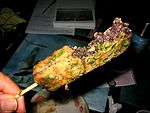
| |
| Lo bah png (Minced pork rice) | 滷肉飯/魯肉飯 | ló͘-bah-pn̄g | lǔròufàn | Fujian | Minced, cubed, or ground fatty pork, stewed in soy sauce and spices, then served on rice. | 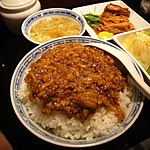
| |
| Khong bah png (Braised pork rice) | 炕肉飯/爌肉飯 | khòng-bah-pn̄g | kàngròufàn | Fujian | Pork chunks, stewed in soy sauce and spices, then served on rice.[3] | 
| |
| Small sausage in large sausage | 大腸包小腸 | tōa-tn̂g pau sió-tn̂g | dàcháng bāo xiǎocháng | Local | A grilled Taiwanese pork sausage wrapped in a grilled, salty, sticky rice sausage. Usually wrapped with garlic and basil. Customer can also choose the flavor they want, such as black pepper, garlic, chili, butter and chocolate. A Taiwanese snack, common in night markets. | 
| |
| Sanbeiji | 三杯雞 | sam-poe-koe | sānbēijī | Jiangxi | A chicken dish which literally translates as "three cups chicken", named because the sauce is made of a cup of rice wine, a cup of sesame oil, and a cup of soy sauce. Alternatively, the sauce can also be made of a cup each of rice wine, sugar and soy sauce.[3] | 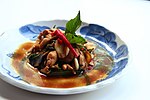
| |
| Dried radish omelet | 菜脯蛋 | chhài-pó͘-nn̄g | càifǔdàn | Local | Finely cut Taiwanese-style preserved white radish cooked into an omelet | 
| |
| olen | 黑輪 | o-lien' | Hēi lún | Japan | This is used fish cake, a fish sauce made with fish soup, than cooked in a pot with different ingredients, similar to Oden. | ||
| Cucumber pork | 瓜子肉 | koe-á bah | guāzǐròu | Guangdong | Steamed, minced pork with Taiwanese-style pickled cucumber. | ||
| Spicy hotpot | 麻辣鍋 | ba-luah e | málàguō | Sichuan | It is increasingly popular, especially in Taipei. The soup of this hotpot is very spicy, inclusive of Chinese herbs and other special materials. People can cook what they want with this soup.[3] | ||
| Eel noodles | 鱔魚意麵 | siān-hî ì-mī | shànyú yìmiàn | Local | Rice eel with Yi mein in a starch-thickened sweet and sour soup. | 
| |
| Tamsui a-gei | 淡水阿給 | Tām-chúi a-geh | Dànshuǐ āgěi | Local | Steamed aburaage tofu stuffed with cooked cellophane noodles and covered with surimi | 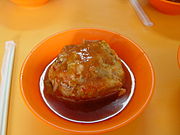
| |
| Danbing | 蛋餅 | nn̄g-piánn | Dàn bǐng | Local | A breakfast dish made by kneading flour, potato starch, glutinous rice flour and water into a thin dough, and an omelet is baked on top. | 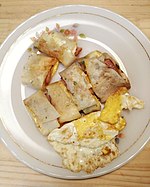
| |
| Iron eggs | 鐵蛋 | thih-nn̄g | tiědàn | Local | Eggs stewed in soy sauce, usually with their shells still on but cracked throughout, until they are flavorful and chewy in texture. | 
| |
| Chhau-a-koe | 草仔粿 | chháu-á-kóe / chháu-á-ké | cǎozaǐguǒ | Fujian | A type of kuih made with glutinous rice flour, sugar, and a ground cooked paste of Jersey cudweed or Chinese mugwort. Often filled with dried shrimp, shiitake mushrooms, white radish (菜脯), and deep-fried shallots. | 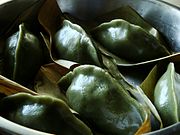
| |
| Moon shrimp cake | 月亮蝦餅 | ge̍h-liāng hê-piánn | yuèliàng xiābǐng | Thai/Southeast Asia | Commonly found in Taiwanese Thai restaurants. Shrimp, garlic, and pork fat are pounded then spread on a circular spring roll wrapper. Another wrapper is placed over top and the cake is pan-fried and served with sweet chili sauce. |  |
|
| Taiwanese Beef Noodle Soup | 臺灣牛肉麵 | dái-wán gu-bà mi | táiwān niúròumiàn | Local | Red-braised version of beef noodle soup. | 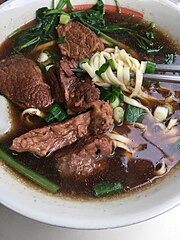
| |
| Tsang Ying Tou | 蒼蠅頭 | cāng yíng tóu | Sichuan | Dish consisting of a stir-fried garlic chives, minced pork, and fermented black beans. | 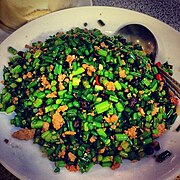
| ||
| Tube rice pudding | 筒仔米糕 | tâng-á-bí-ko | Tǒng zǐ mǐ gāo | Local | Dish consisting of a stir-fried glutinous rice mixture that is seasoned and steamed in a bamboo tube. | 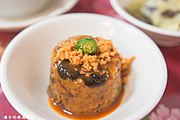
|
There is a type of outdoor barbecue called khòng-iô. To barbecue in this manner, one first builds a hollow pyramid up with dirt clods. Next, charcoal or wood is burnt inside until the temperature inside the pyramid is very high (the dirt clods should be glowing red). The ingredients to be cooked, such as taro, yam, or chicken, are placed in cans, and the cans are placed inside the pyramid. Finally, the pyramid is toppled over the food until cooked.
Many non-dessert dishes are usually considered snacks, not entrees; that is, they have a similar status to Cantonese dim sum or Spanish tapas. Such dishes are usually only slightly salted, with many vegetables accompanying the main meat or seafood item.
- Taiwanese dishes
-
Popiah with vegetables and powdered peanuts as filling
-
A bowl of oyster vermicelli
-
Ba-wan served with sweet and savory sauce
-
Pork ball and rice vermicelli in soup
-
A-gei served with sauce
-
Many flavors of Taiwanese sausages are sold by night market vendors
-
A Fenchihu Bento box
Desserts
[edit]
- Aiyu jelly – a gelatinous dessert made from the seeds of a creeping fig, Ficus pumila var. awkeotsang. Served on ice.[3][18]
- O'ahping (芋仔冰; ō͘-á-peng) – an ice cream made of taro root paste.
- Tshuah-ping (also known as Baobing) – a Taiwanese shaved ice dessert very common in China, Taiwan, Malaysia, and Vietnam.[3]
- Xue-bing (雪花冰) - also called "xue hua bing," translated to "snow ice," "snowflake ice," or "shaved snow." This is different from baobing/tshuah-ping in that the base mixture for the ice is creamy (milk is generally added, but it can be dairy or plant based), the ice itself often has a flavor dissolved in (milk, taro, chocolate, coffee, etc.), the texture of the shaved snow is very fine, and it melts near-instantaneously, upon contact. The ice for this is typically cylindrical, and the shaved snow comes out of the machine in ruffled ribbons. Some additional common toppings include but are not limited to: sweetened condensed milk, mangoes, sweetened red beans, sweetened mung beans, boba pearls, or taro.
- Bubble tea, aka boba milk tea; also known as pearl milk tea - chewy tapioca balls added to milk tea.[18]
- Traditional cakes are not always of the same composition depending on the flavor. There is the moon cake which has a thick filling usually made from lotus seed paste or sweetened red bean paste and surrounded by a relatively thin (2–3 mm) crust and may contain yolks from salted duck eggs. It is traditionally eaten during the festival for lunar worship and moon watching. Mooncakes are offered between friends or on family gatherings while celebrating the festival. The Mid-Autumn Festival is one of the four most important Chinese festivals.
- There are other cakes that can mix salty ingredients with sweet ones to create a balance while enjoying these delicacies with tea. The crust could be shiny from applying a layer of egg yolk before putting in the oven, or not in that case it is often whiter and the crust has more layers.
- Grass jelly (Chinese: 仙草; Pe̍h-ōe-jī: sian-chháu) – (Mesona procumbens) Served hot or cold.
- Moachi (麻糍; môa-chî), a soft rice cake like Japanese daifuku mochi. Flavors of the fillings can vary, ranging from all kinds of beans to nuts.[18]
- Pineapple cake - a square short crust pie filled with pineapple filling. One of Taiwan's best known dessert pastries and souvenir of choice.[3]
- Chhau-a-koe – Cakes made with a dough from glutinous rice flour and combine with a ground cooked paste of Gnaphalium affine or Mugwort to give it a unique flavor and green color. The dough is commonly filled with ground meat or sweet bean pastes.
- Douhua (豆花) - Soft tofu served with syrup and toppings such as peanuts, adzuki beans, tapioca, and mung beans. Served hot or cold.
- Chocolate - Taiwan's cocoa production is centered in Pingtung in Southern Taiwan. As of 2020 approximately 200-300 acres was under cultivation in Pingtung supporting around 30 chocolate making companies.[50][51] Taiwan is one of the few mature chocolate making countries to also be a cocoa producer.[50]
Night market dishes
[edit]Taiwan's best-known snacks are present in the night markets, where street vendors sell a variety of different foods, from finger foods, drinks, sweets, to sit-down dishes. In these markets, one can also find fried and steamed meat-filled buns, oyster-filled omelets, refreshing fruit ices, and much more. Aside from snacks, appetizers, entrees, and desserts, night markets also have vendors selling clothes, accessories, and offer all kinds of entertainment and products.[52] Street vendors used to be common across Taiwan but due to increasing regulations and health safety concerns are now primarily found at night markets and food courts. Taiwanese food courts incorporate ideas from traditional night markets a well as importing ideas from the United States and Japan. Food courts have become ubiquitous across Taiwan. Many night market dishes can now be found outside night markets.[8]
In 2014, The Guardian called Taiwan's night markets the "best street food markets in the world".[52] Some, such as Shilin Night Market, have become as popular with tourists than they are with locals leading to complaints that they've lost a measure of their authentic flavor though commercialization.[8]
| Common English term | Han Characters | Taiwanese Hokkien (Tâi-lô) | Mandarin Pinyin | Influence | Description | Photo |
|---|---|---|---|---|---|---|
| Takoyaki | 章魚燒 | Japanese | A ball-shaped snack that is filled with diced octopus and fried in a flour-based batter, and it can be eaten with condiments such as wasabi. They are commonly found at night markets.[53] | |||
| Wheel cake | 車輪餅 | chhia-lûn-piáⁿ | chēlúnbǐng | Japanese | Pancake batter is poured into hot-metallic molds and gets quickly cooked into small cakes of various shapes. Countless variations exist. Sometimes the cakes have fillings ranging from cream, red bean paste, to peanut butter. Similar to Imagawayaki or Taiyaki | |
| Stinky tofu | 臭豆腐 | chhàu-tāu-hū | chòudòufǔ | Chinese | Stinky tofu is popular in Taiwan. It is called as "Stinky tofu" because of its strong unpleasant odour.[18] Back in the Qing dynasty, Stinky tofu was already a dish in the royal family's meal. Besides, it was also one of the favorite foods of the Empress Dowager Cixi. Stinky tofu can generally be classified into two main kinds, which are soft stinky tofu (臭豆腐乳) and dried stinky tofu (臭豆腐乾). | 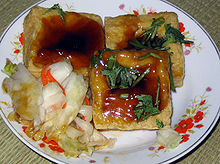 |
| Taiwanese meatball | 肉圓 | bah-oân | ròuyuán | Local | A sticky gelatinous tapioca dough filled with pork, bamboo shoots, shiitake mushrooms, and served with a savory sweet and spicy sauce. |  |
| Maize | 玉米 | yùmǐ | American | Vendors may specialize in one type of corn or they could offer varieties between savory/salty and sweet corn. The corn is either steamed, grilled, boiled, etc. | ||
| Taiwanese sausages | 香腸 | ian-chhiâng (煙腸) | xiāngcháng | Chinese | Fatty pork sausages with a mild sweet taste. There are several different kinds. Kaoliang wine is sometimes used in the sausage recipe. In night markets they are often served on a stick with many different condiments. Sometimes, they are wrapped in glutinous rice. In the very early 1980s, when resources were still relatively scarce, the standard serving is one sausage link on a toothpick garnished with a clove of garlic. | |
| Green onion pancake | 蔥油餅 | cōngyóubǐng | Chinese | Spring onion flour pancake with many thin layers, made with scallions (chopped green onions). Cheese and egg are popular additional fillings.[18] A snack originating in the Chinese mainland. | ||
| Tanghulu | 糖葫蘆 | tánghúlú | Chinese | Red candy coated bite-sized fruit served on a stick. Sometimes the fruit is stuffed with preserved plums, and then candied. Cherry tomatoes and strawberries are also used. |  | |
| Grilled squid | 烤花枝 | kǎo huāzhī | Japanese | Grilled squid often marinated and basted while grilled. | 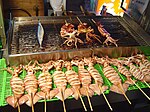
| |
| Shaved ice | 礤冰/剉冰/刨冰 | chhoah-peng | cuòbīng/bàobīng | Local | Finely shaven ice with a variety of toppings (peanuts, fruit, azuki beans, sweetened corn, and so on). Sometimes served drizzled with condensed milk.[18] | |
| Oden | 甜不辣 | tiánbùlà | Japanese | Deep-fried surimi and fish cakes simmered in broth and served with a sweet sauce. It is similar to Satsuma-age, which in some regions in Japan is called Tempura. Otherwise, it is not related to Japanese Tempura, similar to Japanese Oden.[18] | ||
| Taiwanese spring roll | 潤餅 | jūn-piáⁿ / lūn-piáⁿ | rùnbǐng | Fujian | The Taiwanese spring roll is a semi-crispy super-thin flour crepe filled with a variety of filling, such as powdered sugar, peanut powder, egg, vegetables, pork and even seafood. Taiwanese spring rolls are made from the same dough as Western crêpes. | 
|
| Shawarma | 沙威馬 | shāwēimǎ | West Asian | A sandwich usually made from spiced, grilled chicken and served on a leavened, white flour bun with julienned cabbage, a slice of tomato, sliced onions, ketchup and mayonnaise. Brought over from Turkey decades ago, the seasoning is quite different from the seasoning used in making shawarma in Turkey. | ||
| Popcorn chicken | 鹹酥雞/鹽酥雞 | kiâm-so͘-ke / kiâm-so͘-koe | xiánsūjī / yánsūjī | American | Popcorn chicken made from spiced, deep-fried chicken topped with salt and pepper and seasoned with fragrantly cooked basil. It is a delicious decadence loved by all for its juicy and tender texture.[18] | 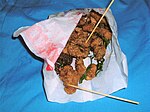
|
| Fried chicken fillet | 炸雞排 | zhá jīpái | American | Fried chicken fillet is one of the most popular snacks in Taiwan.[18] Fried chicken fillets first appeared in Taiwan over 20 years ago but have changed over the years as vendors have concocted new flavors and preparation methods. Unlike the fried chicken served in most fast-food restaurants, this treat is made of chicken breast that has been pounded flat, marinated, battered and deep-fried. After cooking, a generous sprinkling of ground pepper is applied. It is crispy on the outside, tender and juicy on the inside. | ||
| Rousong or Pork Floss | 肉鬆 | Ròusōng | Chinese | 
|
- Various drinks are also often sold, ranging from bubble tea stands to various juice and tea stands.[18]
- Crêpes - Adapted from the original French version, a thin cooked pancake, it has a much crispier texture, rather like a cracker. They were popular in the early 2000s.
- Fruit or bean smoothies - milk or ice is blended on the spot with fresh papaya, mango, watermelon, azuki bean, or mung bean.
- Fried glutinous rice balls - slightly sweet.
Food of the Taiwanese Aborigines
[edit]Taiwan's food and food culture is very much diversified and largely influenced by the exodus of Han people. However, one part of the Taiwanese food culture that remains integral is that of the Taiwanese indigenous people. Though indigenous populations only make up approximately 1.5% of Taiwan's overall population,[54] it is notable that their foods eaten and ways of preparation are distinguishable from the more typical Chinese-influenced cuisine.
The aborigines' diet very much depends on nature. With profuse vegetation and wild animals, the aborigines were natural hunter-gatherers. Essentially, much of what Aborigines ate depended on their environment – that is, whether they lived in coastal or mountainous areas.[55] Tribes like Amis, Atayal, Saisiyat and Bunun hunt what they can, and gather what they cultivate. On the other hand, tribes like the Yamis and the Thao have fish as a predominant source of food. Most foods consisted of millet, taro, sweet potato, wild greens and game like boar and rat. This is in contrast to the main foods eaten by the Han, which consisted of rice and chicken.
Game meats for those living in the mountainous areas include deer, and flying squirrel intestines, a delicacy as regarded by the Bunun people. Another is 'stinky' meat – that is, 'maggoty game' that has begun to rot, which is then barbecued, fried, seasoned with garlic and ginger then served with spicy sauce.[56]
The Amis, apart from meat, had much greens to eat, largely due to the belief that anything a cow ate, was also edible by humans. The Bununs, who are primarily hunters of wild animals, would dine on stone-grilled pork, boar, deer, and hog roast. The Yami tribe, located off Taitung coast, fed on many types of fish, including the prized 'flying fish' (or Alibangbang). A speciality includes rice, mixed with river fish and wild vegetables, served in large bamboo trunks.
Apart from being a staple-food, millet was always produced as wine. Not just for drinking, millet wine played an important role in being used as offerings during festivals, births and weddings. Millet wines are all made in the homes of the Aborigines. Sticky rice is put into a wooden steamer after being soaked in water. Once cooled, the rice is put into a pot of water, then pulled out and combined with rice yeast. After four or five days of being placed in a large jar, the rice is placed in a sieve or rice bag, whilst the alcoholic liquid drips out and is stored away.
Also important to the Indigenous Taiwanese people's cuisine are the sweet potato and taro, favored for their perennial nature and low maintenance. The cultivation of root vegetables rather than typical seedling plants was notably prominent, with archaeological evidence suggesting as early as fourth millennium BC, from the Dapenkeng site, in Guanyin Mountain, New Taipei City.
Given the versatility of both vegetables, they were usually boiled or steamed, and eaten by itself or as ingredients in soups and stews. Without the need for advanced agricultural technology, taro and sweet potatoes were a prime preference for farming. Canadian missionary George MacKay said of 19th century Taiwan: 'the bulb of the sweet potato is planted in March. In about six weeks the vines are cut into pieces eight inches long, which are planted in drills, and from these vine-cuttings the bulbs grow and are ripe about the end of June. A second crop is planted in a similar way in July and is ripe in November.' [57] The influence of sweet potatoes and taro has been vast. They are still widely present in modern-day Taiwan, be it on the streets, night markets, or in successful food chains like 'Meet Fresh' (or 鮮芋仙).
Due to the absence of contemporary culinary utensils such as the refrigerator, gas stovetops and ovens, the Indigenous resorted to other means to prepare their food. Upon bringing back hunted game meat, the Aborigines would preserve the meat with either millet wine or salt. Another cooking technique involved the heating up of stones by fire, which are then placed inside a vessel with other certain meats and seafood, which are cooked from the heat of the stones. Foods were mostly prepared by steaming, boiling or roasting, in order to infuse flavors together, yet preserve the original flavors. This again is contrasted with the Han, who adopted skills like stir-frying and stewing.[58] Meat was also put on a bamboo spit and cooked over the fire.
Taiwanese indigenous cuisine incorporates certain flavors that are distinct from Han Chinese-influenced cuisine. Mountain peppercorns (shan hujiao in Chinese or magao, derived from the Atayal term maqaw) are one of these distinctive ingredients. [59]
A cookbook published in 2000 by the CIP and National Kaohsiung University of Hospitality and Tourism, listed some foods of the main Taiwanese Aboriginal tribes, showing the Aborigines' adherence and passion for natural foods.
- Amis Nation: Alivongvong (meat and sticky rice dumpling packed in leaves) (阿里鳳鳳); Stir-fried wild vegetables
- Atayal Nation: Grilled meat on stone (石板烤肉); Langying (steamed sticky rice cake) (朗應)
- Bunun Nation: Bunun millet cake (布農粿); Millet rice (小米飯)
- Paiwan Nation: Millet Qinafu (millet and pork meat-ball) (小米奇那富); Jinbole (Sorghum and pork dumpling packed in a banana leaf) (金伯樂)
- Puyuma Nation: Yinafei mountain cake (以那馡山地粿); Fried wild rat with basil (九層野鼠)
- Rukai Nation: Qinabu (taro and meat dumpling) (奇那步); Grilled boar
- Saisiyat Nation: Grilled boar with papaya (木瓜拌山豬肉); Assorted wild flowers (野花拼盤); Cassava and spareribs soup (樹薯排骨湯)
- Tsou Nation: Bamboo cooked rice (竹筒飯); Banana cake (香蕉糕)
- Yami Nation: Boiled taro and crab (芋泥加蟹肉); Grilled fish Steamed dried fish (蒸魚乾)
Modern Aboriginal cuisine
[edit]It seems that an interest in Taiwanese indigenous cuisine gained traction in the media in the mid-1990s, developing alongside increasing governmental action to protect and recognize Taiwanese indigenous peoples. There are restaurants around Taipei that keep the spirit of Indigenous cuisine alive. Whilst chefs in such restaurants often tweak traditional recipes to suit contemporary tastebuds, emphasis of natural foods is still extant. The annual Indigenous Peoples Healthy Cuisine and Innovative Beverage Competition, partly sponsored by the Council of Indigenous Peoples and the Tourism Bureau provides prize money to contestants who creatively use traditional indigenous ingredients in healthy ways. Other similar competitions are held by local governments (such as Kaohsiung City). In Tainan, indigenous people may sell their food at the Cha Ha Mu Aboriginal Park. Such trends are all to promote the wonderful taste of Aboriginal Taiwanese cuisine.[56] The cultural value of indigenous dishes and ingredients has become more widespread among non-indigenous people, but there are many implications with this growth in recent years. Cultivating or foraging for traditional ingredients is often limited on the small plots of land that are legally owned by indigenous people. Some urban Pangcah/Amis people have resorted to foraging without permission on others' land.[60]
During the martial law period indigenous culture was repressed by the government, despite this indigenous cuisine became a part of Taiwan's national identity.[6]
Silaw is an Amis dish of pickled pork.[61]
The importance of wild greens to aboriginal cuisine is being increasingly appreciated. Wild greens refers to both wild plants found in the forest and to those same plants cultivated in domestic gardens.[62] Rinari, in rural Pingtung County, is an aboriginal restaurant of national significance whose twenty seats are notoriously hard to secure. Rinari primarily serves Rukai cuisine.[63]
Beverages
[edit]The Taiwanese drink less alcohol per capita than neighboring South Koreans and Japanese. This is believed to be because approximately half of Taiwan's population does not possess the necessary gene to successfully metabolize alcohol. During the Japanese colonial period the production of alcoholic beverages was industrialized and in 1922, production of alcohol was monopolized by the colonial authorities. Modern Taiwanese drinking culture and beverage production is still influenced by the Japanese colonial period.[64]
Beer
[edit]Beer is a popular beverage in Taiwan. Taiwan both imports and produces a wide variety of beers from mass market lagers to niche craft ales. Some of the well-developed brands include Long Chuan (龍泉), Le Blé d'Or (金色三麥), Jolly Brewery+Restaurant (卓莉手工醸啤酒泰食餐廳), North Taiwan Brewing (北台灣麥酒) and Taihu Brewing (臺虎精釀).[65]
Coffee
[edit]The first coffee plants on Taiwan were imported by the British to Tainan in 1884 with the first significant small scale cultivation taking place in New Taipei City's Sanxia District. Tainan remains the heart of Taiwanese coffee culture. Production reached a peak in 1941 following the introduction of arabica coffee plants by the Japanese colonial authorities.[66] Domestic production is small but of high quality, imported beans account for the vast majority of coffee sold in Taiwan. In 2016, domestic production was 900 tons while 30,000 tons was imported.[67]
By 2020, there were more than 15,000 coffee shops in Taiwan.[68] In 2020, average coffee consumption surpassed average tea consumption for the first time.[69]
Kaoliang liquor
[edit]
Kinmen Kaoliang Liquor is one of the most popular brands of kaoliang liquor in Taiwan. As its name indicates, it is produced on the island of Kinmen. The mainstays of the range are the standard 58 percent and 38 percent alcohol bottlings. Kinmen's kaoliang production traces its roots back to the Chinese Civil War when Chinese nationalist general Hu Lien encouraged Kinmenese farmers to grow sorghum to produce hard liquor as importing alcohol from Taiwan caused financial strain. Kaoliang liquor has become an integral part of Kinmen's economy and plays a significant role in the culture of Kinmen.[70]
Yusan Kaoliang Chiew (Chinese: 玉山高粱酒; pinyin: Yùshān Gāoliáng Jiǔ) is produced by the Taiwan Tobacco and Liquor Corporation. It is named after the highest mountain in Taiwan, Yushan. One of the most notable products in the range is an "X.O." kaoliang aged for five years in tanks before bottling.[71]
Matsu Tunnel 88 Kaoliang Liquor (Chinese: 馬祖八八坑道高粱酒; pinyin: Bā Bā Kēngdào Gāoliáng Jiǔ) is produced by the Matsu Distillery in Nangan Township, Lienchiang County. The name is derived from the name of an abandoned military tunnel called Tunnel 88 which the distillery took over as storage space for their kaoliang and aged rice wine. All of the distillery's aged kaoliangs are stored in the tunnel for at least five years.[72]
Rum
[edit]Commercial rum production was introduced into Taiwan along with commercial sugar production during the Japanese colonial period.[73] Rum production continued under the ROC however it was neglected by Taiwan Tobacco and Liquor Corporation which held the national liquor monopoly. The industry diversified after democratization and the de-monopolization of the Taiwanese alcoholic beverage industry.[74]
Tea
[edit]Taiwanese tea is considered among the best in the world and the country has a unique tea culture.[75]
Whisky
[edit]Taiwan has a young but thriving whisky industry buoyed by a massive domestic market for whisky, especially single malt scotch. Taiwan is the only whisky market which drinks more single malt whisky than blended whisky.[76]
Wine
[edit]Independent winemaking was illegal in Taiwan for a long time due to the monopoly granted to the Taiwan Tobacco and Liquor Corporation.[77] Independent winemakers became legal in 2002 and in 2014, a Taiwanese wine won its first gold medal at an international competition.[78] In 2019, a red wine from Taichung was awarded a gold medal at the 25th Vinalies Internationales in France.[79] Two of the most acclaimed wineries are Domaine Shu Sheng and Weightstone Vineyard Estate & Winery.[80] Although it was once largely lost, Taiwan's indigenous winemaking culture is staging a comeback.[81]
Sake
[edit]Sake consumption started during the Japanese colonial period. The first sake was made in Taiwan in 1914, the largest contemporary domestic brand is Yuchun produced by the Taiwan Tobacco and Liquor Corporation. A number of smaller producers also exist with an emphasis placed on unique products made with local rice. Taiwan also imports large amounts of sake from Japan. Its proximity and the volume of the trade allows merchants in Taiwan to stock fresh and limited production sake which is not widely available elsewhere outside Japan.[82]
Fine dining
[edit]Fine dining in Taiwan is often of a mixed identity. For example, wedding banquets in Taiwan typically feature Japanese sashimi as the first course with traditional Taiwanese and Chinese dishes following.[83] In the 21st century, indigenous ingredients, dishes, and techniques have made their way into high end restaurants.[84]
In 2018, La Liste listed 10 restaurants in Taiwan among the world's 1,000 best.[85]
The Michelin Guide began reviewing restaurants in Taipei in 2018 and Taichung in 2020. The 2020 Michelin awarded stars to 30 restaurants in Taiwan, four in Taichung and 26 in Taipei. With three stars, the Cantonese restaurant Le Palais is the country's highest rated restaurant. The 2020 list also bestowed the Bib Gourmand on 54 restaurants in Taipei[86] and 21 in Taichung.[87] The expansion of the Michelin Guide to Taiwan increased international recognition for Taiwanese restaurants.[88] In 2023, the Michelin Guide was expanded to Tainan and Kaohsiung.[89]
There are significant differences between the fine dining scenes in Taipei and Taichung. In Taichung, an emphasis is placed on ceremony with large tables and private rooms common, a premium is also placed on parking with restaurants having more than 100 parking spaces. This is due in part to Taichung's strong small and medium enterprises as well as a multitude of informal recreational and fraternal organizations. In Taipei, fine dining restaurants and tables are generally smaller with most customers being couples or small groups, in general, service is less formal than in Taichung. In Taipei, there is more international influence in the fine dining scene while Taichung retains a strong affinity with traditional dishes.[90] In the 2010s, fine dining restaurants which more closely followed international trends proliferated in Taichung. Lanshu Chen was particularly important in gaining Taichung international recognition.[91]
Foreign cuisine in Taiwan
[edit]Fusion
[edit]Fusion cuisine is very popular in Taiwan. Many Taiwanese dishes are a result of cultural fusion, such as the Taiwanese version of pastel de nata which are a legacy of Portuguese colonialism in neighboring Macao.[92]
Italian
[edit]Italian cuisine has been popular in Taiwan for a long time, but the country had few authentic Italian restaurants and even fewer Italian chefs until the late 1990s and early 2000s. Due to the financial crisis of 2007–08, a large number of Italians emigrated from Italy to healthier economies. This led to a rapid increase in both the number of Italian restaurants and the number of Italian expats in Taiwan. While most restaurants follow the traditional Italian course style, the meal proportions are influenced by Italian-American cuisine. Taiwanese diners have become increasingly passionate and discerning about Italian cuisine.[93] Michael de Prenda was one of the innovators of Italian cuisine in Taiwan, starting multiple restaurants, a market, and a farm.[94]
Pizza
[edit]Pizza is one of the most popular foods in Taiwan. The first pizza restaurant opened in the 1970s and the industry grew rapidly in the 2000s driven by an increasing demand for quality Italian and American style pizza from an affluent younger generation which had spent time abroad and brought back a taste for it.[95]
Chain pizza restaurants like Pizza Hut and Domino's Pizza are known for running promotional pizzas with outrageous toppings like spicy hotpot, cilantro and century egg with pig's blood, beef and kiwi, glutinous rice, ramen, and stinky tofu in an attempt to get national and international publicity. Pizza Hut entered the Taiwanese market in 1986 and Domino's followed in the late 1980s. In 2022, each company had more than 150 stores in Taiwan.[95]
Indian
[edit]Historically overseas Chinese from India would travel to Taiwan to learn cooking. Indian restaurants existed in Taiwan, but overall the cuisine was slow to catch on.[96]
Indian food became popular in Taiwan in the 2000s. The number of Indian restaurants has grown along with the growth of the Indian and larger South Asian community in Taiwan, however, most customers in Indian restaurants are local with Indian food also being found in university cafeterias and other institutional settings.[97]
Russian
[edit]Along with the fleeing KMT came White Russian refugees who had sought shelter from the Russian Revolution in China. George Elsner founded the first Russian restaurant, The Café Astoria, in Taiwan in 1949. The Café Astoria was a center of Russian expat life in Taiwan during its early years. Chiang Ching-kuo and his Russian wife, Faina Vakhreva, often brought their children with them to eat there. Elsner died stateless in Taiwan.[98]
Nordic
[edit]Nordic haute cuisine is popular in Taiwan's major cities, with restaurants offering both authentic Nordic cuisine and Nordic cuisine adapted to local ingredients and tastes.[99][100]
Hong Kong
[edit]The increase in immigration from Hong Kong following the pro-democracy protests brought an increased focus on Hong Kong cuisine, along with a fusion between Hong Kong and Taiwan cuisines. Taiwan is considered a safe haven for Hongkongers, with many opening shops and restaurants to serve food they were unable to find in Taiwan, or which they did not feel was up to Hong Kong standards.[101]
Japanese
[edit]Taiwan, in particularly Taipei, is regarded as having some of the best Japanese food outside of Japan. This is due to the legacy of Japanese colonialism as well as ongoing cultural and commercial exchange.[102]
Ramen
[edit]Ramen restaurants in Taiwan often create unique and outlandish ramen dishes including durian,[103] whole giant isopod,[104][105] crocodile leg,[106] and whole frog.[107]
Burmese
[edit]Burmese and Chinese Burmese restaurants are primarily located in the Little Burma section of Taipei. Chinese Burmese immigration to Taiwan began in the 1950s.[108]
Chinese
[edit]In the decades since the KMT's retreat, these regional dishes have evolved and become part of Taiwanese cuisine.[4]
According to Taiwanese chef Fu Pei-mei, authentic Chinese culinary traditions were properly preserved in Taiwan. This claim to authenticity, common among Fu's generation, was in part due to the Kuomintang's Chinese nationalist political messaging which extended well beyond cuisine.[9] The authenticity of regional Chinese cuisine in Taiwan has been challenged.[6]
Singaporean
[edit]Taiwan has a significant Singaporean community. In 2020, the Taichung-based JL Studio from Singaporean chef Jimmy Lim Tyan Yaw was awarded a second Michelin star, becoming the highest rated Singaporean restaurant in the world.[109]
Taiwanese cuisine abroad
[edit]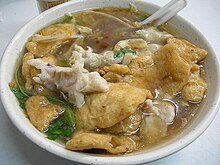
Taiwanese cuisine has a global presence.[110] Taiwanese chefs have been extremely successful abroad cooking both Taiwanese and international cuisine. Well known chefs include André Chiang.[111]
Culinary diplomacy
[edit]Along with its semiconductor industry, Taiwan's cuisine is one of its most prominent aspects internationally.[6] Taiwan has used culinary diplomacy to bolster its tourism sector and to conduct diplomacy in countries with which it has limited official ties.[112] In 2010, Taiwan's Ministry of Economic Affairs launched a £20-million culinary diplomacy campaign called "All in Good Taste: Savor the Flavors of Taiwan".[113] It promoted Taiwanese venues internationally, sponsored chefs, hosted food festivals and competitions, and emphasized elements such as bubble tea, oyster omelette, and Taiwan's night markets.[114] Since 2010, the ministry has sent chefs abroad to promote Taiwanese cuisine.[115]
Banquets
[edit]State banquets have formed an important part of Taiwanese diplomacy since the era of one-party rule by the KMT. General Tso's chicken was invented by the KMT's head chef Peng Chang-kuei in the 1950s to feed visiting American military dignitaries.[116]
The banquets are meant to present a message to guests and as such dishes and styles have varied over the years under different administrations. There has been an increasing emphasis on serving Taiwanese ingredients cooked in a distinctly Taiwanese style.[117]
United States
[edit]Taiwanese immigrant restaurateurs were largely responsible for the shift of American Chinese food from Cantonese-focused cuisine to diverse cuisine featuring dishes from many regions in China. The immigration of Taiwanese chefs to the United States began in the 1950s. At the time, cooks in Taiwan were trained in traditional Chinese regional cooking as this fit the chosen identity of the KMT. Taiwanese restaurateurs changed the food landscape of many American cities, including New York City, and pioneered innovations such as picture menus and food delivery. Many of the immigrants to the United States during this period had been born in mainland China and fled to Taiwan with the retreating KMT, particularly former residents of the Dachen Islands who had been evacuated in 1955.[118]
Traditionally, Taiwanese food has been hard to differentiate from Chinese and Japanese food abroad, since many Taiwanese chefs cooked simplified or westernized versions of traditional Taiwanese, Japanese, or Chinese dishes. In 2018, there was a rapid growth in the number of authentic Taiwanese restaurants in New York City[119][120][121] and across the country, which coincided with an increased interest in regional Chinese food and in Taiwan itself.[122] Some object to the politically fraught inclusion of Taiwanese cuisine under the banner of regional Chinese food and point out that it is inaccurate.[123]
Taiwanese American cuisine is emerging as a full cuisine in its own right. Myers + Chang in Boston was one of the first restaurants to explicitly describe their food as such. In 2018, James Beard Award-winning chef Stephanie Izard opened a Taiwanese snack/dessert shop in Chicago.[124] Taiwanese cuisine has a significant presence in the San Francisco Bay Area.[123] Most Taiwanese restaurants in the Bay Area are located in the suburbs.[125] Increasing interest in authentic Taiwanese food is coming from ex-pats and second generation Taiwanese Americans.[126]
A Taiwanese American cookbook, First Generation, was published by Frankie Gaw in 2022.[127][128][129] In 2023, Cathy Erway published Win Son Presents: A Taiwanese American Cookbook.[130]
Kato by Chef Jon Yao is a Michelin starred restaurant serving Taiwanese food in Los Angeles.[131]
Culinary education
[edit]Historically, culinary education was informal with apprentices learning from a master for many years before they practice the craft on their own. The first college level course in cooking was implemented in 1986 at Danshui Technical College.[110]
Culinary schools
[edit]- Danshui Technical College[110]
- National Kaohsiung University of Hospitality and Tourism[110]
Events
[edit]The main cooking show in Taiwan is the Taiwan Culinary Exhibition (TCE).[132][133] In 2023, the TCE was held at the Taipei World Trade Center the and featured four areas "Gourmet Tastes, Culinary Exploration, Government Pavilion, and Exotic Foods."[12]
See also
[edit]References
[edit]- ^ Chang, Erchen (12 May 2023). "A taste of Taiwan, from comforting noodles to spicy broths". National Geographic. Archived from the original on 12 May 2023. Retrieved 18 May 2023.
- ^ Wahn, I-Liang (8 February 2022). "Food, Politics and Solidarity Economies in Taiwan". Taiwan Insight. University of Nottingham Taiwan Studies Programme. Retrieved 14 May 2023.
- ^ a b c d e f g h i j k Nguyen-Okwu, Leslie (6 March 2019). "16 Dishes That Define Taiwanese Food". Eater. Archived from the original on 13 April 2020. Retrieved 27 April 2020.
- ^ a b Rao, Tejal (21 August 2022). "In a tense political moment, Taiwanese cuisine tells its own story". Japan Times. Retrieved 21 August 2022.
- ^ Rao, Tejal (16 August 2022). "In a Tense Political Moment, Taiwanese Cuisine Tells Its Own Story". The New York Times. Retrieved 13 August 2023.
- ^ a b c d e f Yuan, Li (8 August 2023). "What Cuisine Means to Taiwan's Identity and Its Clash With China". The New York Times. Retrieved 13 August 2023.
- ^ a b Chen, Lina (19 March 2017). "Origins of Taiwanese Fusion Cuisine: It's Not That Simple". The News Lens. Retrieved 24 August 2023.
- ^ a b c d Quartly, Jules (22 January 2017). "From Night Market Treats to Food Court Fine Dining". The News Lens. Retrieved 24 August 2023.
- ^ a b King, Michelle Tien, ed. (2019). Culinary nationalism in Asia. London, UK. pp. 56–72. ISBN 978-1-350-07869-7. OCLC 1100471127.
((cite book)): CS1 maint: location missing publisher (link) - ^ Tseng, Esther (6 February 2024). "Tradition and Innovation: The Protein Power of Instant Noodles". The News Lens. Retrieved 9 February 2024.
- ^ Wei, Clarissa (2 October 2022). "Forget the Instant Pot, Taiwanese steamer Tatung makes everything from fish to rice to cake – and at last it's easier to buy in the US". South China Morning Post. Retrieved 13 August 2023.
- ^ a b "Plenty to Chew on at the Taiwan Culinary Exhibition". Taiwan Business Topics. 13 July 2023. Retrieved 24 August 2023.
- ^ OUNG, ANGELICA (31 January 2023). "Green Dining Gains Recognition in Taiwan". Taiwan Business Topics. Retrieved 5 February 2023.
- ^ a b c d Goossaert, Vincent; David A. Palmer (2011). The Religious Question in Modern China. University of Chicago Press. pp. 281–283. ISBN 9780226304168.
- ^ a b Su, Lynn. "A Rice Renaissance". Taiwan Panorama. Retrieved 16 December 2020.
- ^ Lin, Sean (30 October 2014). "History behind Taiwanese cuisine revealed". Taipei Times. Archived from the original on 3 June 2020. Retrieved 3 June 2020.
- ^ Chang, Meg (31 July 2009). "Groupers help boost nation's aquaculture industry". Taiwan Today. Archived from the original on 7 June 2020. Retrieved 7 June 2020.
- ^ a b c d e f g h i j k l m n Hiufu Wong, Maggie (24 July 2015). "40 of the best Taiwanese foods and drinks". CNN. Retrieved 29 September 2020.
- ^ Gardner, Dinah (11 January 2023). "Decoding Dumplings in Taiwan". Taiwan Business Topics. Retrieved 13 August 2023.
- ^ "Taiwan Country Profile". Food Export Association of the Midwest USA and Food Export USA–Northeast. Retrieved 21 July 2021.
- ^ Lee, Daphne K. (4 May 2022). "In New York, Taiwanese Chefs Are Attempting To Define Their Cuisine". Vice. Retrieved 13 August 2023.
- ^ "What is Parsley?". HowStuffWorks. 21 November 2007. Retrieved 14 March 2022.
- ^ Tchea, Michelle (27 October 2021). "Taiwanese basil is more than a garnish — it's the main event". SBS. Retrieved 27 October 2021.
- ^ Chang, Erchen (12 May 2023). "A taste of Taiwan, from comforting noodles to spicy broths". National Geographic. Archived from the original on 12 May 2023. Retrieved 12 May 2023.
- ^ Wei, Clarissa (22 September 2023). "Sweet and sour pineapple prawns". BBC Travel. Retrieved 23 September 2023.
- ^ Wei, Clarissa (29 May 2021). "Black Vinegar Doesn't Just Season a Dish–It Transforms It". Bon Appétit. Retrieved 30 May 2021.
- ^ Wei, Clarissa (25 January 2023). "Taiwanese Soy Paste Is the Sweet, Glossy Base of My Favorite Sauces". Bon Appétit. Retrieved 13 August 2023.
- ^ "How Did Taiwan Become an Eaters' Paradise?". Taiwan News. 12 August 2023. Retrieved 9 February 2024.
- ^ Lin, Ming-teh (2006). "Popular Food Culture in Taiwan". Government Information Office. Archived from the original on 20 June 2012. Retrieved 15 December 2010.
- ^ Tsai, Luke (26 July 2023). "Why Taiwanese People Love Outdoor Grilling". KQED. Retrieved 13 August 2023.
- ^ Koutsakis, George. "Chef Summit Held In Taiwan: Asia's Biggest Culinary Event Of 2020". Forbes. Retrieved 5 January 2021.
- ^ Jen, Victoria. "Taiwan local street banquet chefs hit hard by dampened Chinese New Year festivities amid COVID-19". Channel News Asia. Retrieved 17 February 2021.
- ^ Scanlan, Sean (4 January 2023). "Netizens complain of boring Taiwanese banquet dishes". Taiwan News. Retrieved 13 August 2023.
- ^ Somekh, Simone (22 February 2018). "Hungry for Kosher Food in Taiwan? Look for the Swastikas". Tablet Magazine. Archived from the original on 4 July 2020. Retrieved 4 July 2020.
- ^ Tseng, Esther. "Taiwan's Vegetarian Awakening". Taiwan Panorama. Retrieved 29 January 2021.
- ^ Xie, Tina. "Meeting New Demand for Vegetarian Foods". Taiwan Panorama. Retrieved 29 January 2021.
- ^ "Taiwan's meatless success a vegetarian paradise". Taiwan News. 6 May 2023. Retrieved 24 August 2023.
- ^ Amster-Burton, Matthew (9 May 2017). "The saucy comforts of Taiwanese turkey rice". The Takeout. Retrieved 29 September 2020.
- ^ Craddock, Kat (18 March 2019). "Taiwan's Coffin Bread Perfects the Art of the Bread Bowl". Saveur. Retrieved 28 January 2020.
- ^ "2019 Daxi Dried Tofu Festival Opening Ceremony". Taoyuan Government. 16 March 2019. Retrieved 29 January 2021.
- ^ "Hsinchu Meatballs". OCAC. Retrieved 29 January 2021.
- ^ Wong, Maggie Hiufu (15 June 2020). "From chow mein to udon: A beginner's guide to Asia's best noodles". CNN. Retrieved 29 January 2021.
- ^ Liao, George (17 October 2019). "'Buy one and get one free' at Pastry Festival in central Taiwan". Taiwan News. Retrieved 29 January 2021.
- ^ Everington, Keoni (3 December 2020). "Historic pastry shop burns down in central Taiwan". Taiwan News. Retrieved 29 January 2021.
- ^ Wei, Clarissa. "Gallery: 25 Things You Must Eat in Tainan, the Culinary Center of Taiwan". Serious Eats. Retrieved 29 January 2021.
- ^ "A-Gei". New Taipei City. Retrieved 29 September 2020.
- ^ Bird, Thomas (9 November 2017). "Taiwan's northern tip: weird nature, wonderful street food". South China Morning Post. Retrieved 29 January 2021.
- ^ "Oyster omelet the nation's favorite". Taipei Times. CNA. 2 June 2007. p. 2. Archived from the original on 17 May 2008. Retrieved 2 June 2007.
- ^ Martin, Laura C. (2007). Tea: The drink that changed the world. Rutland: Tuttle Publishing. p. 219. ISBN 9780804837248.
- ^ a b Cheung, Han (15 September 2020). "Tree to bar to gold". Taipei Times. Archived from the original on 17 September 2020. Retrieved 25 September 2020.
- ^ Su, Lynn. "A Sweet Vision: Taiwanese Chocolate's Road to the World". Taiwan Panorama. Archived from the original on 26 September 2020. Retrieved 10 December 2019.
- ^ a b Gillan, Audrey (17 May 2014). "Taiwan, home to the best street food markets in the world". The Guardian. Archived from the original on 16 May 2020. Retrieved 27 April 2020.
- ^ Joe, Melinda (24 February 2018). "In Taiwan, top chefs are building on a long history of culinary exchange with Japan". Japan Times. ISSN 0447-5763. Archived from the original on 4 August 2018. Retrieved 5 September 2018.
- ^ Trejaut, Jean A; Kivisild, Toomas; Loo, Jun Hun; Lee, Chien Liang; He, Chun Lin; Hsu, Chia Jung; Li, Zheng Yuan; Lin, Marie (5 July 2005). "Traces of Archaic Mitochondrial Lineages Persist in Austronesian-Speaking Formosan Populations". PLOS Biology. 3 (8): e247. doi:10.1371/journal.pbio.0030247. PMC 1166350. PMID 15984912.
- ^ 國際化,雙語編排,文化整合,全球華人的雜誌, 台灣光華雜誌 Taiwan Panorama |. "Indigenous Food: The Authentic Flavors of Taiwan". 台灣光華雜誌 Taiwan Panorama | 國際化,雙語編排,文化整合,全球華人的雜誌 (in Chinese). Retrieved 5 March 2024.
((cite web)): CS1 maint: multiple names: authors list (link) - ^ a b "Aboriginal Cuisine Comes to Town". Taiwan Today. Retrieved 5 March 2024.
- ^ Mackay, George Leslie; MacDonald, James A. (James Alexander) (1896). From far Formosa : the island, its people and missions. University of California Libraries. Edinburgh : Oliphant Anderson and Ferrier. p. 67.
- ^ Chen, Y. J. (2010, June 15). Embodying nation in food consumption : changing boundaries of "Taiwanese cuisine" (1895-2008). Retrieved from https://hdl.handle.net/1887/15690
- ^ Crook, Steven; Hung, Katy Hui-wen (8 October 2018). A Culinary History of Taipei: Beyond Pork and Ponlai. Rowman & Littlefield. pp. 20–21. ISBN 978-1-5381-0138-4.
- ^ Sugimoto, Tomonori (2018). ""Someone Else's Land is Our Garden!": Risky Labor in Taipei's Indigenous Food Boom". Gastronomica. 18 (2): 46–58. doi:10.1525/gfc.2018.18.2.46. ISSN 1529-3262. JSTOR 26499172.
- ^ Cheung, Han (21 October 2022). "Eating local in indigenous Taitung". Taipei Times. Retrieved 18 November 2022.
- ^ Cheung, Han (30 April 2022). "Taiwan's 'godmother of wild greens'". Taipei Times. Retrieved 5 May 2022.
- ^ Tham, Davina (20 April 2019). "Restaurants: Modern Aboriginal cuisine". Taipei Times. Retrieved 24 August 2023.
- ^ Crook, Steven (23 April 2021). "Highways & Byways: Taiwan's boozy past and present". Taipei Times. Retrieved 6 May 2021.
- ^ Chou, Cybil Huichen (11 May 2019). "How Taiwanese craft beers are finding fans in Asia and the West". South China Morning Post. Archived from the original on 18 September 2019. Retrieved 28 July 2020.
- ^ Staff Writer (17 February 2021). "FEATURE: Growers along Tainan's 'Coffee Road' want to put local brew on national map". Taipei Times. Retrieved 17 February 2021.
- ^ "Coffee culture booms in Taiwan". Agencia EFE. Retrieved 30 November 2020.
- ^ News Desk. "Coffee culture on the rise in Taiwan". The Jakarta Post. Archived from the original on 29 July 2020. Retrieved 28 July 2020.
- ^ Yuan-ting, Yang; Chung, Jake (31 August 2021). "Coffee consumption exceeds that of tea for the first time". Taipei Times. Retrieved 31 August 2021.
- ^ China (Taiwan), Ministry of Foreign Affairs, Republic of (18 March 2011). "Kaoliang serves Kinmen a tasty future". Taiwan Today. Retrieved 12 June 2020.
((cite web)): CS1 maint: multiple names: authors list (link) - ^ "嘉義酒廠目前主力產品".
- ^ "八八坑道高粱酒官方網站".
- ^ du Toit, Nick (29 July 2011). "Yo-ho-ho and a bottle of Koxinga Gold rum". Taiwan Today. Retrieved 8 June 2021.
- ^ Koutsakis, George (6 June 2021). "Will Japanese whisky be eclipsed by Taiwan? The island's gin and rum also show promise – with one distillery promising spirits 'good enough for God'". South China Morning Post. Retrieved 8 June 2021.
- ^ Crook, Steven (9 July 2020). "Exploring the World of Taiwanese Tea". Taiwan Business Topics. Archived from the original on 15 July 2020. Retrieved 28 July 2020.
- ^ Koutsakis, George (6 October 2019). "Can Taiwan's premium gin producers take on the world – and Taiwanese drinkers who prefer foreign liquor?". South China Morning Post. Archived from the original on 23 November 2019. Retrieved 28 July 2020.
- ^ Whithead, Richard (5 May 2020). "Tropical terroir made to produce award-winning wines". Beverage Daily. Archived from the original on 9 May 2020. Retrieved 5 May 2020.
- ^ Cheung, Han (21 March 2020). "Vina Formosa comes of age". Taipei Times. Archived from the original on 23 March 2020. Retrieved 23 March 2020.
- ^ Hui-ning, Hu (10 March 2019). "Taichung red wine wins gold medal in France". Taipei Times. Archived from the original on 2 September 2019. Retrieved 30 April 2020.
- ^ Huichen Chou, Cybil (14 September 2019). "Why Hong Kong connoisseurs – and Michelin-star chefs – are taking note of Taiwan's wines". South China Morning Post. Archived from the original on 7 July 2020. Retrieved 30 April 2020.
- ^ Wang, Ann. "Taiwan's award-winning winemaker aims to revive fading tradition". The Jakarta Post. Reuters. Archived from the original on 10 August 2020. Retrieved 8 August 2020.
- ^ CHOU, CYBIL. "Taiwan sake boom starts to challenge Japanese traditions". Nikkei Asia. Retrieved 14 March 2022.
- ^ Haggerty, Nicholas (25 September 2020). "Beyond the Michelin Guide: What Is Real Taiwanese Gourmet?". The News Lens. Archived from the original on 26 September 2020. Retrieved 26 September 2020.
- ^ KRICH, JOHN. "Taiwan chefs go back to island's roots". Nikkei Asia. Retrieved 13 August 2023.
- ^ Yang, Sophia (15 December 2018). "10 Taiwan restaurants listed among world's top 1000 by La Liste". Taiwan News. Retrieved 24 August 2023.
- ^ Sontag, Elazar (25 August 2020). "Michelin Announces 2020 Stars for Taiwan". Eater. Archived from the original on 26 September 2020. Retrieved 25 September 2020.
- ^ Hsin-Yin, Lee (11 August 2020). "Michelin Guide releases Bib Gourmand list for Taipei, Taichung". Focus Taiwan. Archived from the original on 26 September 2020. Retrieved 25 September 2020.
- ^ Teo, Mavis (15 February 2023). "6 of the best fine-dining restaurants in Taiwan's capital, Taipei, for Taiwanese, Japanese, Cantonese and Huaiyang cuisine". South China Morning Post. Retrieved 13 August 2023.
- ^ Shan, Shelley (24 August 2023). "Michelin reveals Taiwan's Bib Gourmand eateries". Taipei Times. Retrieved 24 August 2023.
- ^ Wu, Sunny (15 January 2021). "Michelin Guide Taiwan – Taipei vs. Taichung". Taiwan Business Topics. Retrieved 15 January 2021.
- ^ Teo, Mavis (7 March 2023). "Where to eat and drink in Taichung, Taiwan's up-and-coming fine-dining hub – from Michelin-star yakiniku to a French bistro by former Asia's Best Female Chef winner". South China Morning Post. Retrieved 24 August 2023.
- ^ Chen, Lina (19 March 2017). "Origins of Taiwanese Fusion Cuisine: It's Not That Simple". The News Lens. Archived from the original on 3 June 2020. Retrieved 3 June 2020.
- ^ Fulco, Matthew (12 January 2018). "Discovering a Little Italy in Taipei". Taiwan Business Topics. Archived from the original on 18 June 2020. Retrieved 1 May 2020.
- ^ Chou, Min. "An Italian Entrepreneur Realizing 'His Meaning of Life' in Taiwan". Commonwealth. Archived from the original on 26 September 2020. Retrieved 1 May 2020.
- ^ a b Quartly, Jules (17 January 2022). "A Golden Era for Pizza in Taiwan". Taiwan Business Topics. Retrieved 5 May 2022.
- ^ Ferry, Timothy (19 January 2018). "Indian Cuisine Heats Up in Taipei". Taiwan Business Topics. Retrieved 24 August 2023.
- ^ Banka, Neha (18 December 2021). "In Taipei, Indian food makes for good business". Indian Express. Retrieved 19 December 2021.
- ^ Strong, Matthew (20 June 2020). "Taiwan's Café Astoria inherits spirit of Russia". Taiwan News. Archived from the original on 22 June 2020. Retrieved 20 June 2020.
- ^ Alamin, Jasmine. "How this young Singaporean chef is making culinary waves in Taiwan". Channel NewsAsia. Archived from the original on 31 December 2019. Retrieved 27 April 2020.
- ^ Sgarbi, Giulia. "Asia's Highest Climber Mume brings Taiwanese produce into the global spotlight". The World's 50 Best. Archived from the original on 26 September 2020. Retrieved 27 April 2020.
- ^ GLAUERT, RIK. "Hong Kong protesters revolutionize Taiwan restaurant scene". Nikkei Asia. Archived from the original on 3 June 2020. Retrieved 3 June 2020.
- ^ Fulco, Matthew (21 January 2021). "Experiencing Taipei's Authentic Japanese Cuisine". Taiwan Business Topics. Retrieved 24 January 2021.
- ^ Thomas, Jono (16 June 2023). "Durian ramen to go on sale in south Taiwan". Taiwan News. Retrieved 13 August 2023.
- ^ Everington, Keoni (23 May 2023). "Taipei eatery features giant isopod ramen". Taiwan News. Retrieved 13 August 2023.
- ^ Mok, Charmaine (24 May 2023). "'Dream ingredient': alien-like isopod ramen dish made with a 14-legged deep-sea creature goes viral in Taiwan". South China Morning Post. Retrieved 13 August 2023.
- ^ Marcus, Lilit; Chang, Wayne (30 June 2023). "Crocodile ramen is Taiwan's latest food fad". CNN. Retrieved 13 August 2023.
- ^ Thomson, Jono (13 June 2023). "Whole, 'uncut, unpeeled' frog ramen on the menu in central Taiwan". Taiwan News. Retrieved 13 August 2023.
- ^ BARON, JAMES (18 January 2023). "Little Burma: Where Great Food Meets Fascinating History". Taiwan Business Topics. Retrieved 13 August 2023.
- ^ Tee, Karen (7 August 2023). "Restaurant with most Michelin stars for Singaporean food... is in Taiwan. Welcome to JL Studio". South China Morning Post. Retrieved 24 August 2023.
- ^ a b c d "Taiwanese cuisine reflects nation's historical odyssey". Taiwan Today. 4 March 2011. Retrieved 27 April 2020.
- ^ Koutsakis, George. "What Makes A Great Chef? Andre Chiang on Cuisine, Growth, And Taiwan's Culinary Beauty". Forbes. Archived from the original on 22 March 2019. Retrieved 27 April 2020.
- ^ Chapple-Sokol, Sam (2013). "Culinary Diplomacy: Breaking Bread to Win Hearts and Minds". The Hague Journal of Diplomacy. 8 (2): 161–183. doi:10.1163/1871191x-12341244.
- ^ "Eight Great Gastrodiplomacy Nations". USC Center on Public Diplomacy. 2 July 2015.
- ^ Booth, Robert (8 August 2010). "Taiwan launches 'gastro-diplomacy' drive". The Guardian. Retrieved 1 April 2020.
- ^ Tzu-hsuan, Liu (21 April 2023). "Chefs selected for global six-month cultural tour". Taipei Times. Retrieved 13 August 2023.
- ^ Tsoi, Grace; Chang, Joy (6 January 2024). "General Tso's chicken to bento bowls: A food guide to Taiwan politics". BBC News. Retrieved 9 February 2024.
- ^ Tzu-hsuan, Liu (9 February 2024). "Taiwanese cuisine wows at state banquets". Taipei Times. Retrieved 9 February 2024.
- ^ Pio Kuo, Chunghao. "Taiwaneze immigrand spark a golden age fore Chinese food". NY Food Story. Archived from the original on 21 September 2020. Retrieved 29 April 2020.
- ^ Wu, Stephenie (5 November 2018). "Taiwanese food is finally having a moment in New York City's crowded restaurant scene". Mic. Archived from the original on 26 September 2020. Retrieved 27 April 2020.
- ^ Gross, Matt (25 July 2018). "New York City's Taiwanese-Food Boom (It's About Time)". Taste Cooking. Archived from the original on 3 June 2020. Retrieved 3 June 2020.
- ^ Sietsema, Robert (22 June 2017). "14 Exceptional Taiwanese Restaurants in NYC". Eater New York. Retrieved 24 August 2023.
- ^ Moskin, Julia (11 June 2019). "A New Generation of Chefs Reframes Taiwanese Cuisine in America". The New York Times. Archived from the original on 1 June 2020. Retrieved 3 June 2020.
- ^ a b Tsai, Luke (19 May 2021). "The Bay Area's Taiwanese Food Scene Comes Into Its Own". KQED. Retrieved 22 May 2021.
- ^ Erway, Cathy. "How Today's Taiwanese-American Chefs Rewrote the Rules and Made a New Cuisine". Food and Wine. Archived from the original on 3 June 2020. Retrieved 3 June 2020.
- ^ Tsai, Luke (11 May 2023). "Taiwanese Food Is Taking Over Union Square — For One Day, Anyway". KQED. Retrieved 13 August 2023.
- ^ Addison, Bill (3 March 2016). "Tradition and Innovation in America's Taiwanese Cooking". Eater. Retrieved 24 August 2023.
- ^ Choe, Caroline (6 December 2022). "Frankie Gaw explores Taiwanese American identity through recipes like Cinnamon Toast Crunch mochi". Today. Retrieved 13 August 2023.
- ^ Varriano, Jackie (26 October 2022). "This Seattleite's debut cookbook explores what Taiwanese American food looks like". Seattle Times. Retrieved 13 August 2023.
- ^ Ngo, Hope (16 October 2022). "New Cookbook First Generation Is A Love Story To Taiwanese-American Cuisine". Tasting Table. Retrieved 13 August 2023.
- ^ Rega, Konstantin (29 July 2023). "Embracing Taiwanese Cuisine". Virginia Living. Retrieved 13 August 2023.
- ^ Chaplin, Cathy (6 July 2023). "Kato Already Has One Michelin Star. Chef Jon Yao Wants More — But Only on His Terms". Eater Los Angeles. Photography by Wonho Frank Lee. Retrieved 9 February 2024.
- ^ "Culinary exhibition starts in Taipei". Taipei Times. 5 August 2023. Retrieved 13 August 2023.
- ^ Shu-yu, Li; Kuan-wei, Wu (7 August 2023). "Cuisine with unique flavors wow visitors at Taiwan food expo". Focus Taiwan. Retrieved 13 August 2023.
Further reading
[edit]- Crook, Steven; Hung, Katy Hui-wen (2018), A Culinary History of Taipei: Beyond Pork and Ponlai, Rowman & Littlefield, ISBN 978-1538101377
- Wei, Clarissa (2023). Made in Taiwan: Recipes and Stories from the Island Nation. with Chen, Ivy. New York: S&S/Simon Element. ISBN 9781982198978.
- —————— (3 October 2023). "The politics of bubble tea: at last, Taiwanese food is getting the recognition it deserves". The Guardian. Retrieved 13 November 2023.
External links
[edit] Media related to Cuisine of Taiwan at Wikimedia Commons
Media related to Cuisine of Taiwan at Wikimedia Commons
| Dishes and meals | ||
|---|---|---|
| Xiaochi |
| |
| Snacks and desserts | ||
| Beverages | ||
| Ingredients | ||
| Chefs | ||
| Miscellaneous | ||
| Sovereign states |
|
|---|---|
States with limited recognition | |
Dependencies and other territories |
|
| Continental | |
|---|---|
| National and regional |
|
| Ethnic |
|
| Religious | |
| Historical |
|
| Styles | |
| Lists | |
| Related | |

